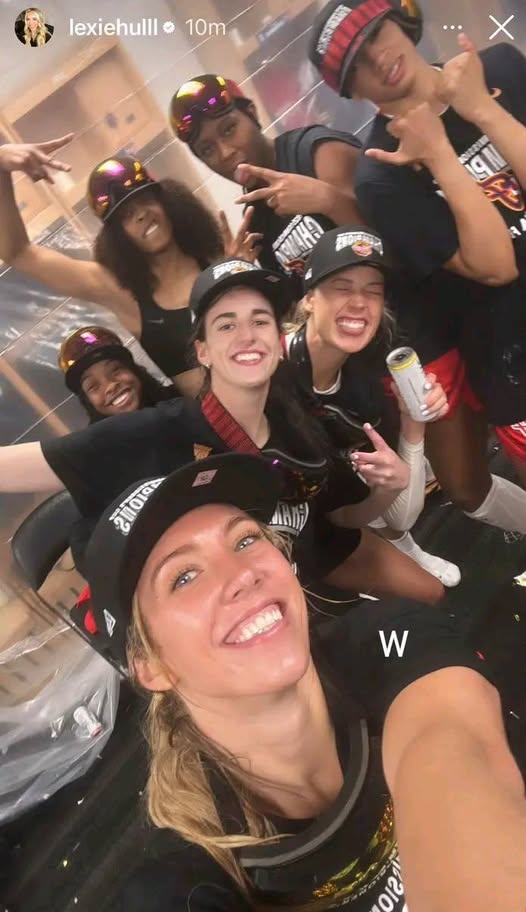Breaking: The Indiana Fever have etched their names into WNBA history by claiming the franchise’s first-ever Commissioner’s Cup championship, defeating the Minnesota Lynx 74–59 in a decisive final on July 1, 2025. The victory, achieved on the road at the Target Center, not only delivered a long-sought trophy but also sparked sweeping reactions—on the court, in locker rooms, across social media, and within the broader discourse on player pay.
The game opened with Minnesota bursting to a 20–12 first-quarter lead, fueled by crisp offense and confident defense. But Indiana, viewed as ten-point underdogs, quickly flipped the momentum. A stunning 18–0 run to close out the second quarter erased the deficit and flipped control firmly to Indiana. That stretch turned the tone of the game, setting the stage for a six-point halftime lead and a sense of belief that underdogs could triumph. The Fever would push the advantage to 14 points in the third, ultimately sealing a 15‑point upset. Minnesota shot a season‑worst 34.9 percent—only 4‑for‑16 from beyond the arc—and committed 16 turnovers .
At the heart of Indiana’s win was a defensive masterclass coupled with balanced scoring. Natasha Howard, returning to her former team, was the unanimous MVP, producing 16 points, 12 rebounds, four assists, and two steals—and drilling all eight of her free throws (. All‑Star center Aliyah Boston posted a 12‑12 double‑double with six assists, underscoring Indiana’s interior dominance. Sharpshooting Sophie Cunningham, coming off the bench, dropped 13 points (3‑of‑5 from three), while veteran guards Kelsey Mitchell and Aari McDonald added 12 apiece
Shockingly, this milestone was accomplished without rookie phenom Caitlin Clark, who missed her third straight game due to a groin injury. Clark, who has burst onto the scene with unprecedented rookie numbers—including leading the league in assists—was forced to watch as her teammates wrote the narrative of redemption and resilience . As she later reflected, watching from the sidelines offered her a fresh lens on game flow and team dynamics .
Post‑game celebrations in the locker room were electric—champagne and even vodka seltzers flowed, with teammates playfully lifting the trophy and chanting through cameras streamed live to fans . Clark herself climbed atop tables, drenched in celebration, her fiery spirit declaring to the camera: “Everybody in the league is sick.” She exclaimed that rivals “p*****,” embracing the team’s new “us vs. everybody” identity .
Pure joy mixed with pointed critique—Clark took to social media to call out inequalities in WNBA prize structures. Though sidelined, she pointed out that Commissioner’s Cup winners each receive roughly $30,000 (some reports say $45,000–50,000), whereas the WNBA Finals champions only earn about $20,800 per player . She cheekily dubbed the tournament “the Cathy Cup,” referencing Commissioner Cathy Engelbert, challenging the logic of rewarding an in‑season tournament more than the league championship (. Her message struck a chord; fans and pundits alike echoed Clark’s critique, placing pressure on the WNBA during ongoing collective bargaining negotiations .
For head coach Stephanie White, the commissioner’s Cup title was not just a trophy—it was proof of depth, determination, and identity. “They’re tough—mentally, physically. They pull for one another,” she said after the win (. Her team, despite injuries and skeptics, proved capable of bucket‑by‑bucket growth. “It’s nice to take a trophy home,” she added, “but this isn’t the ultimate goal… we’ve got to continue to get better” .
On the other side, Minnesota coach Cheryl Reeve and her Lynx squad faced unexpected failure. A team known for offensive efficiency and composure stumbled—snapping their league‑leading 14 straight wins as double‑digit favorites . Napheesa Collier, Minnesota’s star, was held to just 12 points on 6‑for‑18 shooting—an uncharacteristic off night . With the loss, Minnesota forfeited both Cup repeat hopes and home‑court dominance in this showcase matchup.
Win or lose, both teams contributed to the WNBA’s growing narrative. Indiana’s success reflects a franchise reborn, fueled by offseason moves like acquiring veterans DeWanna Bonner and Natasha Howard under the leadership of rising star Caitlin Clark . The strategic mix of veteran savvy and youthful talent—surrounding Clark with experience and defensive tenacity—has paid dividends . Meanwhile Minnesota’s stumble served as a reminder: in-season tournaments can be unpredictable and carry weight far beyond their format.
Financially, Indiana’s win brought a $500,000 prize pool, shared equally across the roster—roughly $45,000–50,000 each. Additionally, sponsor Coinbase contributed $120,000 in cryptocurrency rewards, bringing in crypto bonuses and fundraising for local nonprofits. Indiana’s chosen nonprofit, Peace Learning Center, will receive a bonus from the championship but already benefited as part of the league’s “No Space for Hate” platform .
Off the court, the win fuels optimism ahead of the regular season’s second half and beyond. The Fever improved to 8–8 but now carry momentum and belief into a five‑game homestand beginning shortly after the trophy run . Historically, Cup finalists often ride the wave into deeper playoff runs, and with Clark nearing a return, expectations are higher than ever .
In broader terms, this Cup final underlined the WNBA’s growth: record attendance (over 400,000 fans in the first month, 156 percent above last year), soaring TV ratings (~1.32 million viewers per game, nearly triple last season), and elevated stakes across narrative and economic dimensions . Clark’s outspoken pay critique also highlights ongoing organizational shifts as the league and its athletes push toward more equitable compensation in the upcoming CBA.
Inside Indiana’s celebratory locker room, amid the flutes of champagne, electric chants, and trophy hoisting, Clark’s voice remains clear: this team can do more, demands more, and will chase bigger goals—even if that means calling out the system. Her blend of spirit and criticism hints at a new WNBA era in which athletes aren’t just stars—they’re change-makers.
Indiana’s Commissioner’s Cup breakthrough won’t erase the regular season’s challenges or guarantee postseason glory—but it offers a statement of identity. Under Coach White’s steady hand and spurred by Clark’s energy and leadership—even from the sidelines—the Fever have transformed into contenders, reshaping expectations of a once-struggling franchise.
As Minnesota regroups and Indiana primes for the stretch run, one thing is sure: this Commissioner’s Cup wasn’t just a tournament win. It was a turning point, a cultural moment, and a signpost of WNBA transformation—on court, within league structures, and across the sport’s landscape. And come September, when playoff seeds fall and trophies matter most, all eyes will be on a team that brought home hardware—and challenged the world to rethink what it values.



